A Report on Opportunities and Barriers of Inclusion in NZ
VerifiedAdded on 2020/03/16
|18
|4075
|49
Report
AI Summary
This report examines the opportunities and barriers to social inclusion, primarily focusing on the context of New Zealand and the challenges faced by adolescents. It delves into issues such as youth suicide, school bullying, binge drinking, and unprotected sex, identifying these as significant barriers to inclusion. The report also highlights opportunities for inclusion, including social participation, social networking, and equal access to education. A key component of the report is the application of the Tidal Model, a recovery-oriented approach to mental health, as a strategy to overcome these barriers. Furthermore, the report outlines government initiatives and strategies in New Zealand aimed at addressing suicide prevention and school bullying, providing a comprehensive overview of the multifaceted challenges and potential solutions related to social inclusion within this specific demographic and geographical context.
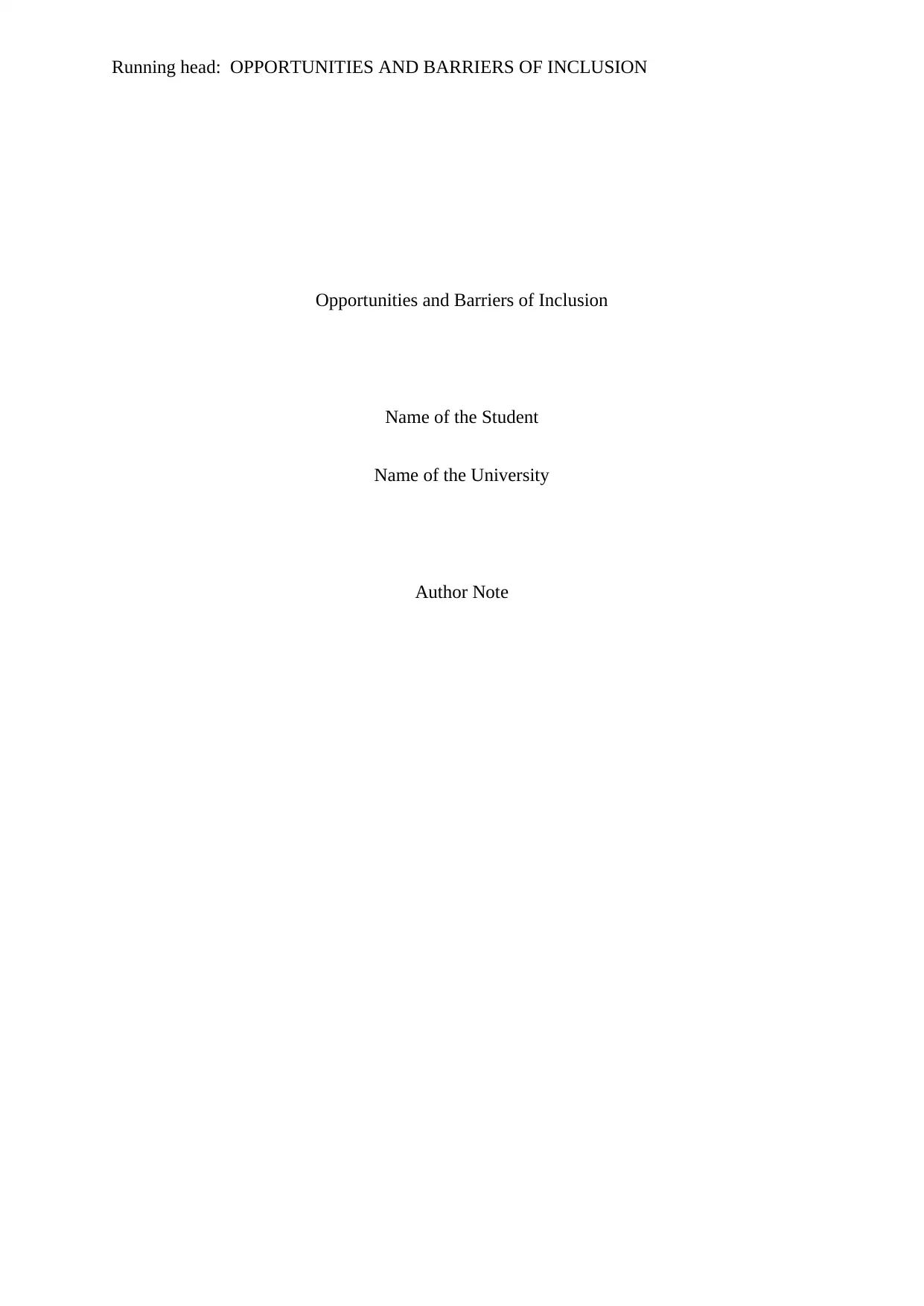
Running head: OPPORTUNITIES AND BARRIERS OF INCLUSION
Opportunities and Barriers of Inclusion
Name of the Student
Name of the University
Author Note
Opportunities and Barriers of Inclusion
Name of the Student
Name of the University
Author Note
Paraphrase This Document
Need a fresh take? Get an instant paraphrase of this document with our AI Paraphraser

1
OPPORTUNITIES AND BARRIERS OF INCLUSION
Table of Contents
Introduction................................................................................................................................2
Discussion of Opportunities and Barriers..................................................................................2
Barriers of Inclusion...............................................................................................................2
Opportunities of Inclusion......................................................................................................4
Recovery Model: Tidal Model...................................................................................................5
New Zealand Government Initiatives and Strategies.................................................................6
Role of Nurse in Recovery.........................................................................................................9
Conclusion................................................................................................................................10
References................................................................................................................................11
Appendix 1...............................................................................................................................15
Appendix 2...............................................................................................................................16
OPPORTUNITIES AND BARRIERS OF INCLUSION
Table of Contents
Introduction................................................................................................................................2
Discussion of Opportunities and Barriers..................................................................................2
Barriers of Inclusion...............................................................................................................2
Opportunities of Inclusion......................................................................................................4
Recovery Model: Tidal Model...................................................................................................5
New Zealand Government Initiatives and Strategies.................................................................6
Role of Nurse in Recovery.........................................................................................................9
Conclusion................................................................................................................................10
References................................................................................................................................11
Appendix 1...............................................................................................................................15
Appendix 2...............................................................................................................................16
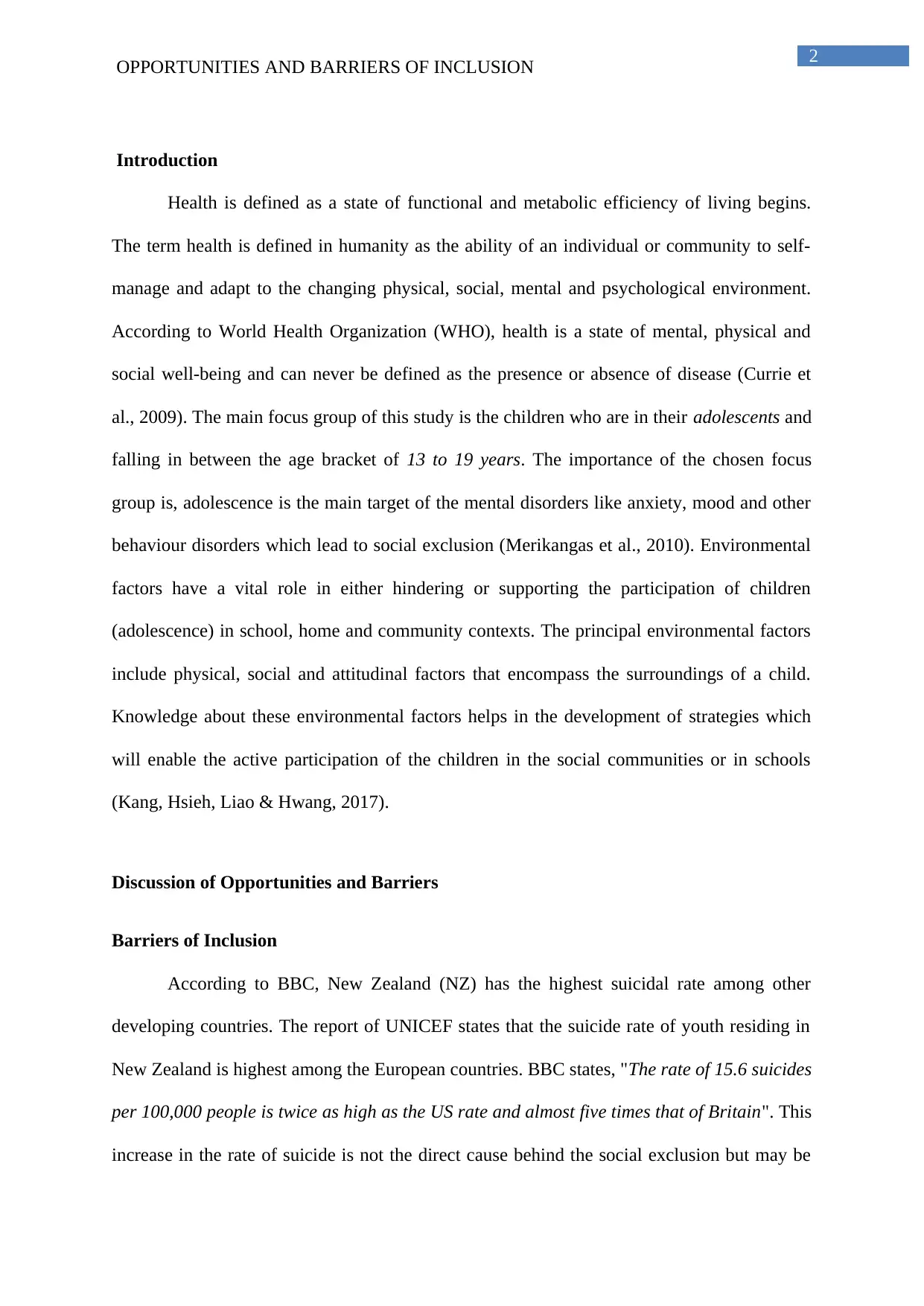
2
OPPORTUNITIES AND BARRIERS OF INCLUSION
Introduction
Health is defined as a state of functional and metabolic efficiency of living begins.
The term health is defined in humanity as the ability of an individual or community to self-
manage and adapt to the changing physical, social, mental and psychological environment.
According to World Health Organization (WHO), health is a state of mental, physical and
social well-being and can never be defined as the presence or absence of disease (Currie et
al., 2009). The main focus group of this study is the children who are in their adolescents and
falling in between the age bracket of 13 to 19 years. The importance of the chosen focus
group is, adolescence is the main target of the mental disorders like anxiety, mood and other
behaviour disorders which lead to social exclusion (Merikangas et al., 2010). Environmental
factors have a vital role in either hindering or supporting the participation of children
(adolescence) in school, home and community contexts. The principal environmental factors
include physical, social and attitudinal factors that encompass the surroundings of a child.
Knowledge about these environmental factors helps in the development of strategies which
will enable the active participation of the children in the social communities or in schools
(Kang, Hsieh, Liao & Hwang, 2017).
Discussion of Opportunities and Barriers
Barriers of Inclusion
According to BBC, New Zealand (NZ) has the highest suicidal rate among other
developing countries. The report of UNICEF states that the suicide rate of youth residing in
New Zealand is highest among the European countries. BBC states, "The rate of 15.6 suicides
per 100,000 people is twice as high as the US rate and almost five times that of Britain". This
increase in the rate of suicide is not the direct cause behind the social exclusion but may be
OPPORTUNITIES AND BARRIERS OF INCLUSION
Introduction
Health is defined as a state of functional and metabolic efficiency of living begins.
The term health is defined in humanity as the ability of an individual or community to self-
manage and adapt to the changing physical, social, mental and psychological environment.
According to World Health Organization (WHO), health is a state of mental, physical and
social well-being and can never be defined as the presence or absence of disease (Currie et
al., 2009). The main focus group of this study is the children who are in their adolescents and
falling in between the age bracket of 13 to 19 years. The importance of the chosen focus
group is, adolescence is the main target of the mental disorders like anxiety, mood and other
behaviour disorders which lead to social exclusion (Merikangas et al., 2010). Environmental
factors have a vital role in either hindering or supporting the participation of children
(adolescence) in school, home and community contexts. The principal environmental factors
include physical, social and attitudinal factors that encompass the surroundings of a child.
Knowledge about these environmental factors helps in the development of strategies which
will enable the active participation of the children in the social communities or in schools
(Kang, Hsieh, Liao & Hwang, 2017).
Discussion of Opportunities and Barriers
Barriers of Inclusion
According to BBC, New Zealand (NZ) has the highest suicidal rate among other
developing countries. The report of UNICEF states that the suicide rate of youth residing in
New Zealand is highest among the European countries. BBC states, "The rate of 15.6 suicides
per 100,000 people is twice as high as the US rate and almost five times that of Britain". This
increase in the rate of suicide is not the direct cause behind the social exclusion but may be
⊘ This is a preview!⊘
Do you want full access?
Subscribe today to unlock all pages.

Trusted by 1+ million students worldwide
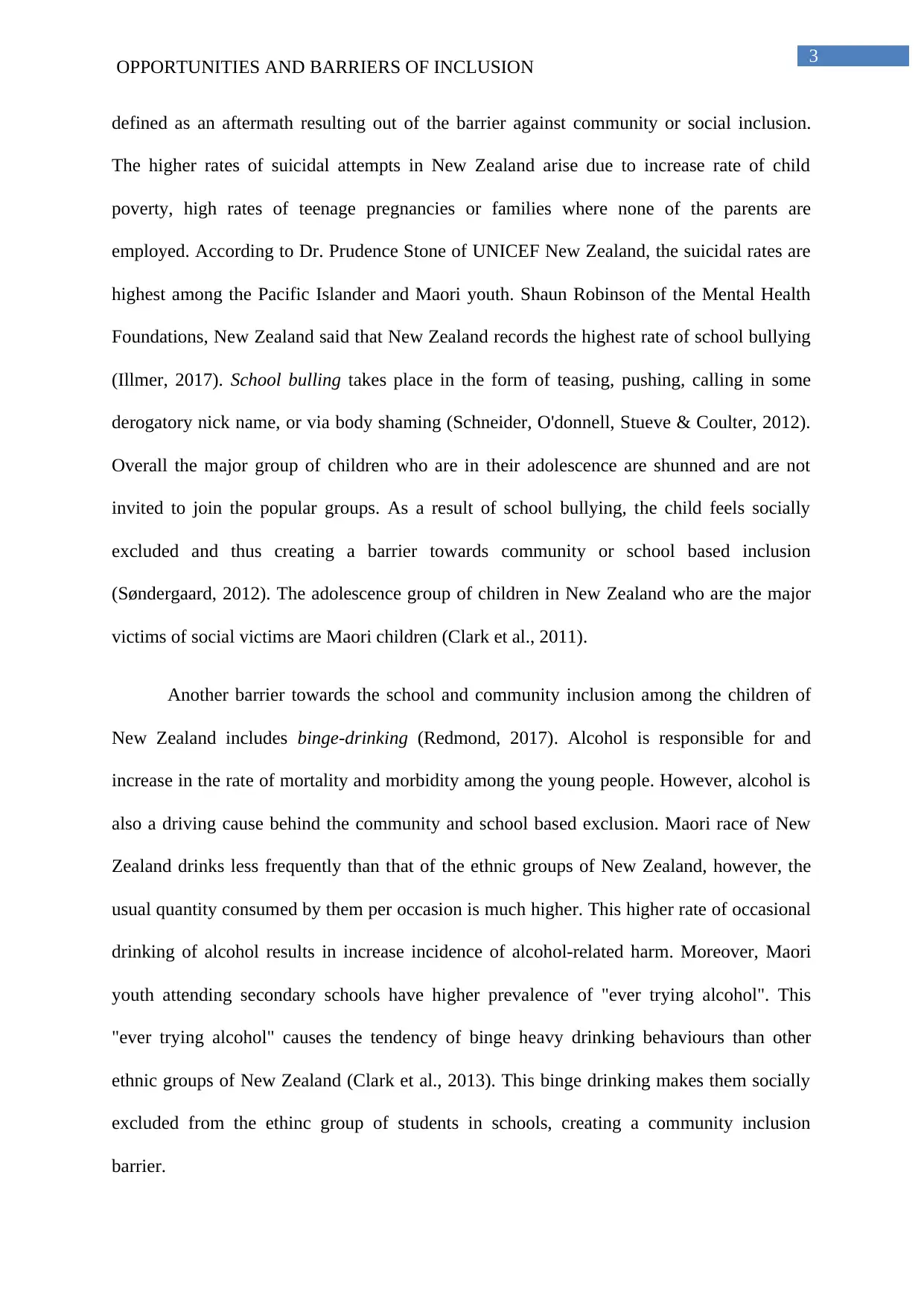
3
OPPORTUNITIES AND BARRIERS OF INCLUSION
defined as an aftermath resulting out of the barrier against community or social inclusion.
The higher rates of suicidal attempts in New Zealand arise due to increase rate of child
poverty, high rates of teenage pregnancies or families where none of the parents are
employed. According to Dr. Prudence Stone of UNICEF New Zealand, the suicidal rates are
highest among the Pacific Islander and Maori youth. Shaun Robinson of the Mental Health
Foundations, New Zealand said that New Zealand records the highest rate of school bullying
(Illmer, 2017). School bulling takes place in the form of teasing, pushing, calling in some
derogatory nick name, or via body shaming (Schneider, O'donnell, Stueve & Coulter, 2012).
Overall the major group of children who are in their adolescence are shunned and are not
invited to join the popular groups. As a result of school bullying, the child feels socially
excluded and thus creating a barrier towards community or school based inclusion
(Søndergaard, 2012). The adolescence group of children in New Zealand who are the major
victims of social victims are Maori children (Clark et al., 2011).
Another barrier towards the school and community inclusion among the children of
New Zealand includes binge-drinking (Redmond, 2017). Alcohol is responsible for and
increase in the rate of mortality and morbidity among the young people. However, alcohol is
also a driving cause behind the community and school based exclusion. Maori race of New
Zealand drinks less frequently than that of the ethnic groups of New Zealand, however, the
usual quantity consumed by them per occasion is much higher. This higher rate of occasional
drinking of alcohol results in increase incidence of alcohol-related harm. Moreover, Maori
youth attending secondary schools have higher prevalence of "ever trying alcohol". This
"ever trying alcohol" causes the tendency of binge heavy drinking behaviours than other
ethnic groups of New Zealand (Clark et al., 2013). This binge drinking makes them socially
excluded from the ethinc group of students in schools, creating a community inclusion
barrier.
OPPORTUNITIES AND BARRIERS OF INCLUSION
defined as an aftermath resulting out of the barrier against community or social inclusion.
The higher rates of suicidal attempts in New Zealand arise due to increase rate of child
poverty, high rates of teenage pregnancies or families where none of the parents are
employed. According to Dr. Prudence Stone of UNICEF New Zealand, the suicidal rates are
highest among the Pacific Islander and Maori youth. Shaun Robinson of the Mental Health
Foundations, New Zealand said that New Zealand records the highest rate of school bullying
(Illmer, 2017). School bulling takes place in the form of teasing, pushing, calling in some
derogatory nick name, or via body shaming (Schneider, O'donnell, Stueve & Coulter, 2012).
Overall the major group of children who are in their adolescence are shunned and are not
invited to join the popular groups. As a result of school bullying, the child feels socially
excluded and thus creating a barrier towards community or school based inclusion
(Søndergaard, 2012). The adolescence group of children in New Zealand who are the major
victims of social victims are Maori children (Clark et al., 2011).
Another barrier towards the school and community inclusion among the children of
New Zealand includes binge-drinking (Redmond, 2017). Alcohol is responsible for and
increase in the rate of mortality and morbidity among the young people. However, alcohol is
also a driving cause behind the community and school based exclusion. Maori race of New
Zealand drinks less frequently than that of the ethnic groups of New Zealand, however, the
usual quantity consumed by them per occasion is much higher. This higher rate of occasional
drinking of alcohol results in increase incidence of alcohol-related harm. Moreover, Maori
youth attending secondary schools have higher prevalence of "ever trying alcohol". This
"ever trying alcohol" causes the tendency of binge heavy drinking behaviours than other
ethnic groups of New Zealand (Clark et al., 2013). This binge drinking makes them socially
excluded from the ethinc group of students in schools, creating a community inclusion
barrier.
Paraphrase This Document
Need a fresh take? Get an instant paraphrase of this document with our AI Paraphraser
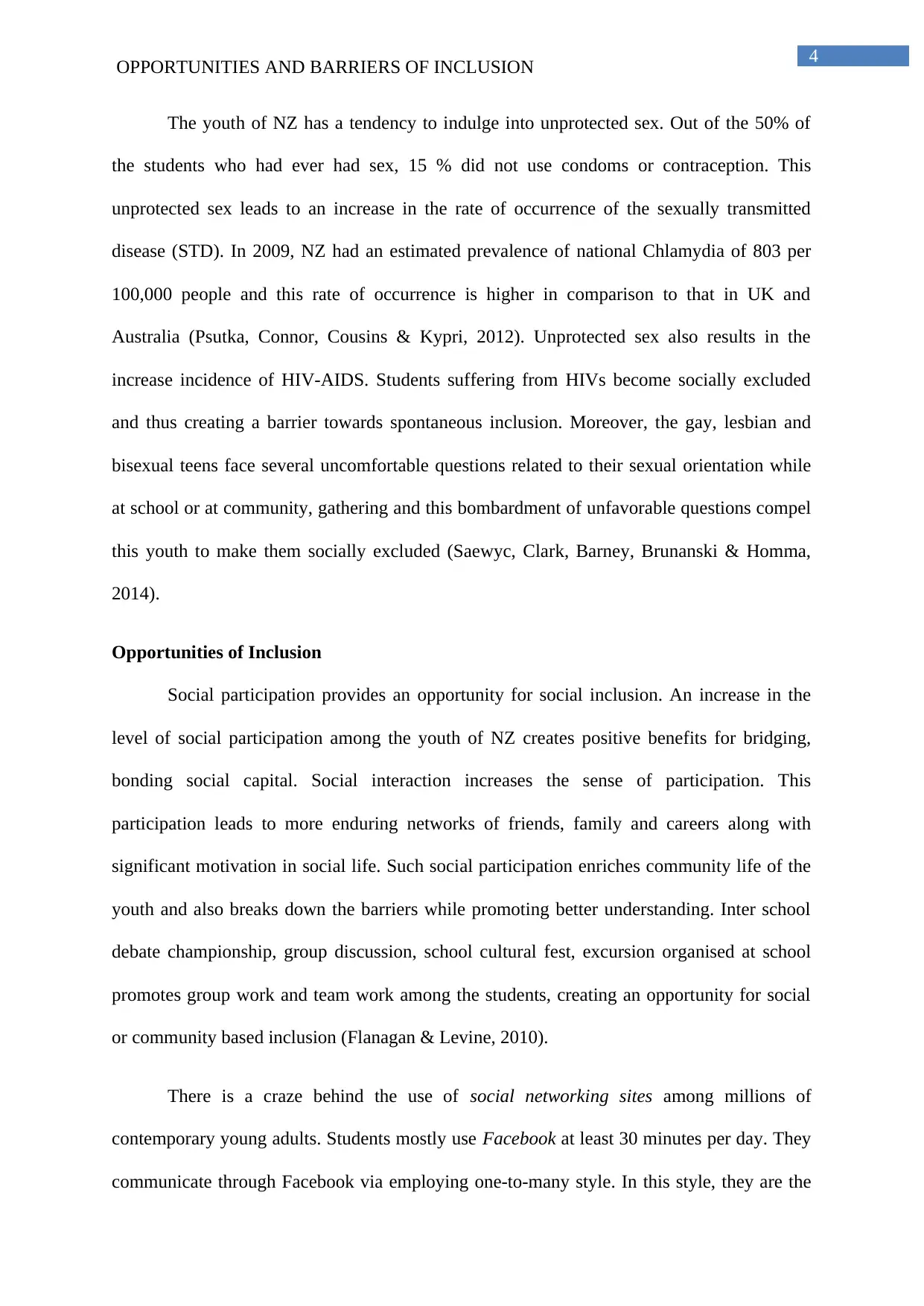
4
OPPORTUNITIES AND BARRIERS OF INCLUSION
The youth of NZ has a tendency to indulge into unprotected sex. Out of the 50% of
the students who had ever had sex, 15 % did not use condoms or contraception. This
unprotected sex leads to an increase in the rate of occurrence of the sexually transmitted
disease (STD). In 2009, NZ had an estimated prevalence of national Chlamydia of 803 per
100,000 people and this rate of occurrence is higher in comparison to that in UK and
Australia (Psutka, Connor, Cousins & Kypri, 2012). Unprotected sex also results in the
increase incidence of HIV-AIDS. Students suffering from HIVs become socially excluded
and thus creating a barrier towards spontaneous inclusion. Moreover, the gay, lesbian and
bisexual teens face several uncomfortable questions related to their sexual orientation while
at school or at community, gathering and this bombardment of unfavorable questions compel
this youth to make them socially excluded (Saewyc, Clark, Barney, Brunanski & Homma,
2014).
Opportunities of Inclusion
Social participation provides an opportunity for social inclusion. An increase in the
level of social participation among the youth of NZ creates positive benefits for bridging,
bonding social capital. Social interaction increases the sense of participation. This
participation leads to more enduring networks of friends, family and careers along with
significant motivation in social life. Such social participation enriches community life of the
youth and also breaks down the barriers while promoting better understanding. Inter school
debate championship, group discussion, school cultural fest, excursion organised at school
promotes group work and team work among the students, creating an opportunity for social
or community based inclusion (Flanagan & Levine, 2010).
There is a craze behind the use of social networking sites among millions of
contemporary young adults. Students mostly use Facebook at least 30 minutes per day. They
communicate through Facebook via employing one-to-many style. In this style, they are the
OPPORTUNITIES AND BARRIERS OF INCLUSION
The youth of NZ has a tendency to indulge into unprotected sex. Out of the 50% of
the students who had ever had sex, 15 % did not use condoms or contraception. This
unprotected sex leads to an increase in the rate of occurrence of the sexually transmitted
disease (STD). In 2009, NZ had an estimated prevalence of national Chlamydia of 803 per
100,000 people and this rate of occurrence is higher in comparison to that in UK and
Australia (Psutka, Connor, Cousins & Kypri, 2012). Unprotected sex also results in the
increase incidence of HIV-AIDS. Students suffering from HIVs become socially excluded
and thus creating a barrier towards spontaneous inclusion. Moreover, the gay, lesbian and
bisexual teens face several uncomfortable questions related to their sexual orientation while
at school or at community, gathering and this bombardment of unfavorable questions compel
this youth to make them socially excluded (Saewyc, Clark, Barney, Brunanski & Homma,
2014).
Opportunities of Inclusion
Social participation provides an opportunity for social inclusion. An increase in the
level of social participation among the youth of NZ creates positive benefits for bridging,
bonding social capital. Social interaction increases the sense of participation. This
participation leads to more enduring networks of friends, family and careers along with
significant motivation in social life. Such social participation enriches community life of the
youth and also breaks down the barriers while promoting better understanding. Inter school
debate championship, group discussion, school cultural fest, excursion organised at school
promotes group work and team work among the students, creating an opportunity for social
or community based inclusion (Flanagan & Levine, 2010).
There is a craze behind the use of social networking sites among millions of
contemporary young adults. Students mostly use Facebook at least 30 minutes per day. They
communicate through Facebook via employing one-to-many style. In this style, they are the
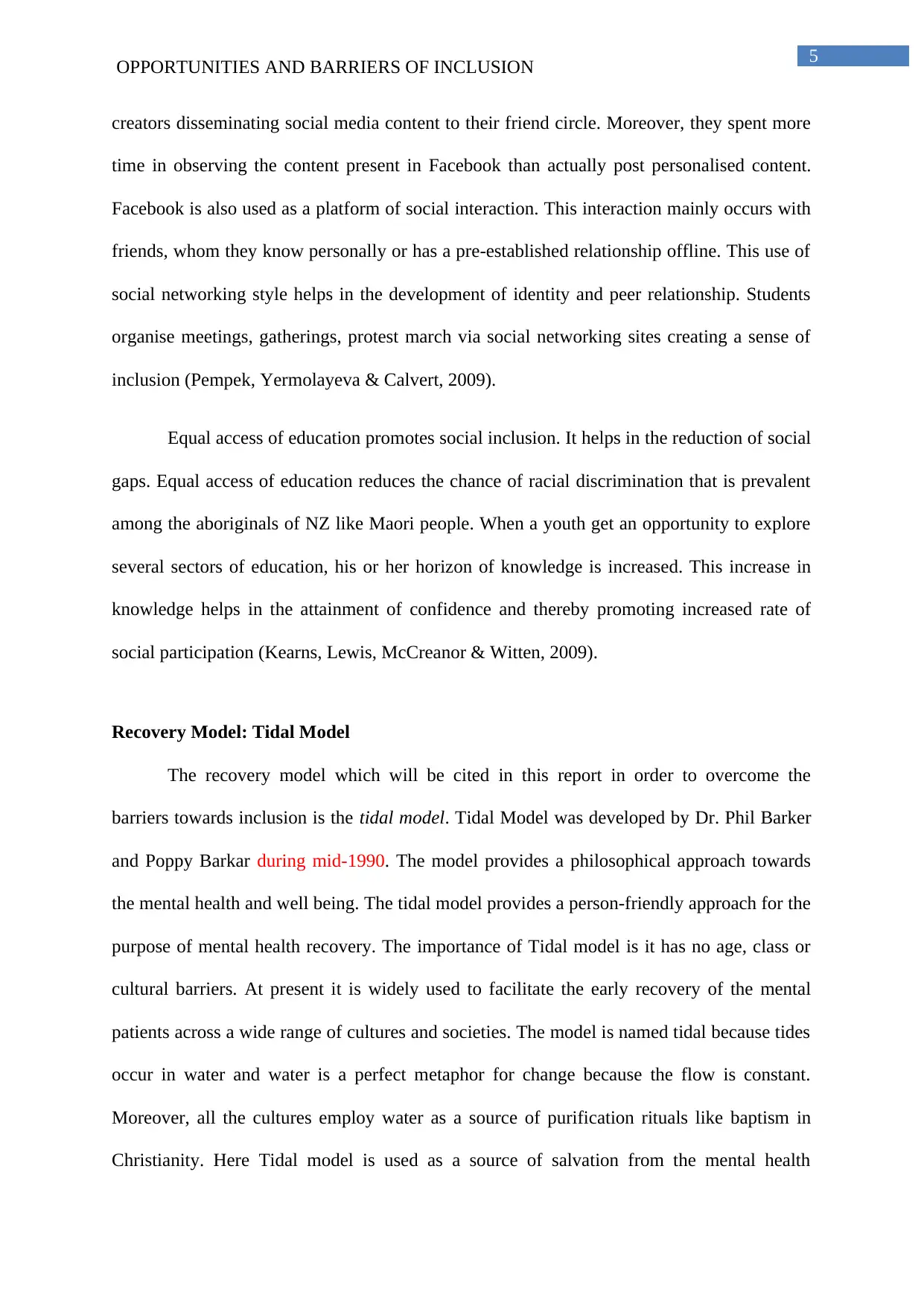
5
OPPORTUNITIES AND BARRIERS OF INCLUSION
creators disseminating social media content to their friend circle. Moreover, they spent more
time in observing the content present in Facebook than actually post personalised content.
Facebook is also used as a platform of social interaction. This interaction mainly occurs with
friends, whom they know personally or has a pre-established relationship offline. This use of
social networking style helps in the development of identity and peer relationship. Students
organise meetings, gatherings, protest march via social networking sites creating a sense of
inclusion (Pempek, Yermolayeva & Calvert, 2009).
Equal access of education promotes social inclusion. It helps in the reduction of social
gaps. Equal access of education reduces the chance of racial discrimination that is prevalent
among the aboriginals of NZ like Maori people. When a youth get an opportunity to explore
several sectors of education, his or her horizon of knowledge is increased. This increase in
knowledge helps in the attainment of confidence and thereby promoting increased rate of
social participation (Kearns, Lewis, McCreanor & Witten, 2009).
Recovery Model: Tidal Model
The recovery model which will be cited in this report in order to overcome the
barriers towards inclusion is the tidal model. Tidal Model was developed by Dr. Phil Barker
and Poppy Barkar during mid-1990. The model provides a philosophical approach towards
the mental health and well being. The tidal model provides a person-friendly approach for the
purpose of mental health recovery. The importance of Tidal model is it has no age, class or
cultural barriers. At present it is widely used to facilitate the early recovery of the mental
patients across a wide range of cultures and societies. The model is named tidal because tides
occur in water and water is a perfect metaphor for change because the flow is constant.
Moreover, all the cultures employ water as a source of purification rituals like baptism in
Christianity. Here Tidal model is used as a source of salvation from the mental health
OPPORTUNITIES AND BARRIERS OF INCLUSION
creators disseminating social media content to their friend circle. Moreover, they spent more
time in observing the content present in Facebook than actually post personalised content.
Facebook is also used as a platform of social interaction. This interaction mainly occurs with
friends, whom they know personally or has a pre-established relationship offline. This use of
social networking style helps in the development of identity and peer relationship. Students
organise meetings, gatherings, protest march via social networking sites creating a sense of
inclusion (Pempek, Yermolayeva & Calvert, 2009).
Equal access of education promotes social inclusion. It helps in the reduction of social
gaps. Equal access of education reduces the chance of racial discrimination that is prevalent
among the aboriginals of NZ like Maori people. When a youth get an opportunity to explore
several sectors of education, his or her horizon of knowledge is increased. This increase in
knowledge helps in the attainment of confidence and thereby promoting increased rate of
social participation (Kearns, Lewis, McCreanor & Witten, 2009).
Recovery Model: Tidal Model
The recovery model which will be cited in this report in order to overcome the
barriers towards inclusion is the tidal model. Tidal Model was developed by Dr. Phil Barker
and Poppy Barkar during mid-1990. The model provides a philosophical approach towards
the mental health and well being. The tidal model provides a person-friendly approach for the
purpose of mental health recovery. The importance of Tidal model is it has no age, class or
cultural barriers. At present it is widely used to facilitate the early recovery of the mental
patients across a wide range of cultures and societies. The model is named tidal because tides
occur in water and water is a perfect metaphor for change because the flow is constant.
Moreover, all the cultures employ water as a source of purification rituals like baptism in
Christianity. Here Tidal model is used as a source of salvation from the mental health
⊘ This is a preview!⊘
Do you want full access?
Subscribe today to unlock all pages.

Trusted by 1+ million students worldwide
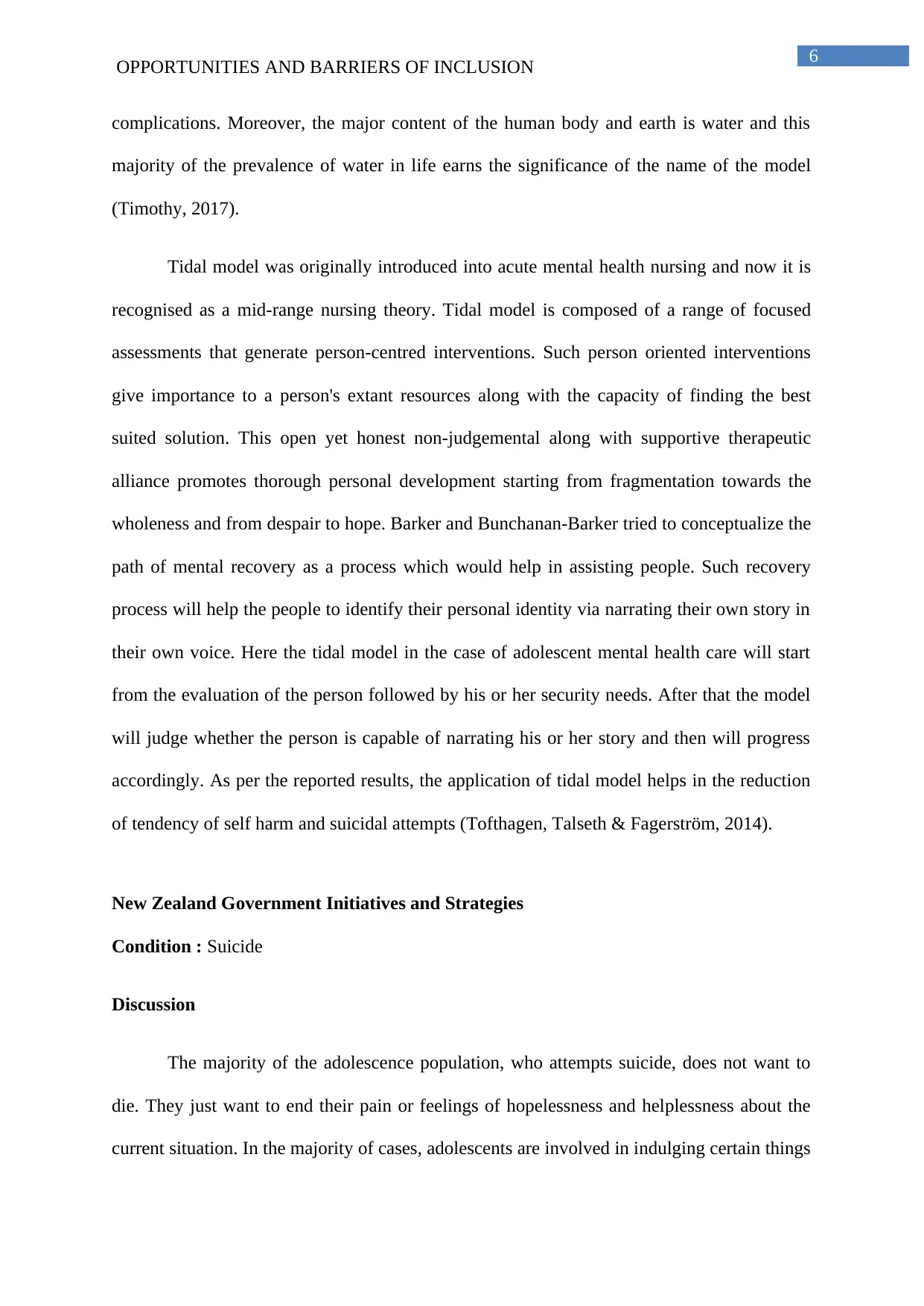
6
OPPORTUNITIES AND BARRIERS OF INCLUSION
complications. Moreover, the major content of the human body and earth is water and this
majority of the prevalence of water in life earns the significance of the name of the model
(Timothy, 2017).
Tidal model was originally introduced into acute mental health nursing and now it is
recognised as a mid-range nursing theory. Tidal model is composed of a range of focused
assessments that generate person-centred interventions. Such person oriented interventions
give importance to a person's extant resources along with the capacity of finding the best
suited solution. This open yet honest non-judgemental along with supportive therapeutic
alliance promotes thorough personal development starting from fragmentation towards the
wholeness and from despair to hope. Barker and Bunchanan-Barker tried to conceptualize the
path of mental recovery as a process which would help in assisting people. Such recovery
process will help the people to identify their personal identity via narrating their own story in
their own voice. Here the tidal model in the case of adolescent mental health care will start
from the evaluation of the person followed by his or her security needs. After that the model
will judge whether the person is capable of narrating his or her story and then will progress
accordingly. As per the reported results, the application of tidal model helps in the reduction
of tendency of self harm and suicidal attempts (Tofthagen, Talseth & Fagerström, 2014).
New Zealand Government Initiatives and Strategies
Condition : Suicide
Discussion
The majority of the adolescence population, who attempts suicide, does not want to
die. They just want to end their pain or feelings of hopelessness and helplessness about the
current situation. In the majority of cases, adolescents are involved in indulging certain things
OPPORTUNITIES AND BARRIERS OF INCLUSION
complications. Moreover, the major content of the human body and earth is water and this
majority of the prevalence of water in life earns the significance of the name of the model
(Timothy, 2017).
Tidal model was originally introduced into acute mental health nursing and now it is
recognised as a mid-range nursing theory. Tidal model is composed of a range of focused
assessments that generate person-centred interventions. Such person oriented interventions
give importance to a person's extant resources along with the capacity of finding the best
suited solution. This open yet honest non-judgemental along with supportive therapeutic
alliance promotes thorough personal development starting from fragmentation towards the
wholeness and from despair to hope. Barker and Bunchanan-Barker tried to conceptualize the
path of mental recovery as a process which would help in assisting people. Such recovery
process will help the people to identify their personal identity via narrating their own story in
their own voice. Here the tidal model in the case of adolescent mental health care will start
from the evaluation of the person followed by his or her security needs. After that the model
will judge whether the person is capable of narrating his or her story and then will progress
accordingly. As per the reported results, the application of tidal model helps in the reduction
of tendency of self harm and suicidal attempts (Tofthagen, Talseth & Fagerström, 2014).
New Zealand Government Initiatives and Strategies
Condition : Suicide
Discussion
The majority of the adolescence population, who attempts suicide, does not want to
die. They just want to end their pain or feelings of hopelessness and helplessness about the
current situation. In the majority of cases, adolescents are involved in indulging certain things
Paraphrase This Document
Need a fresh take? Get an instant paraphrase of this document with our AI Paraphraser
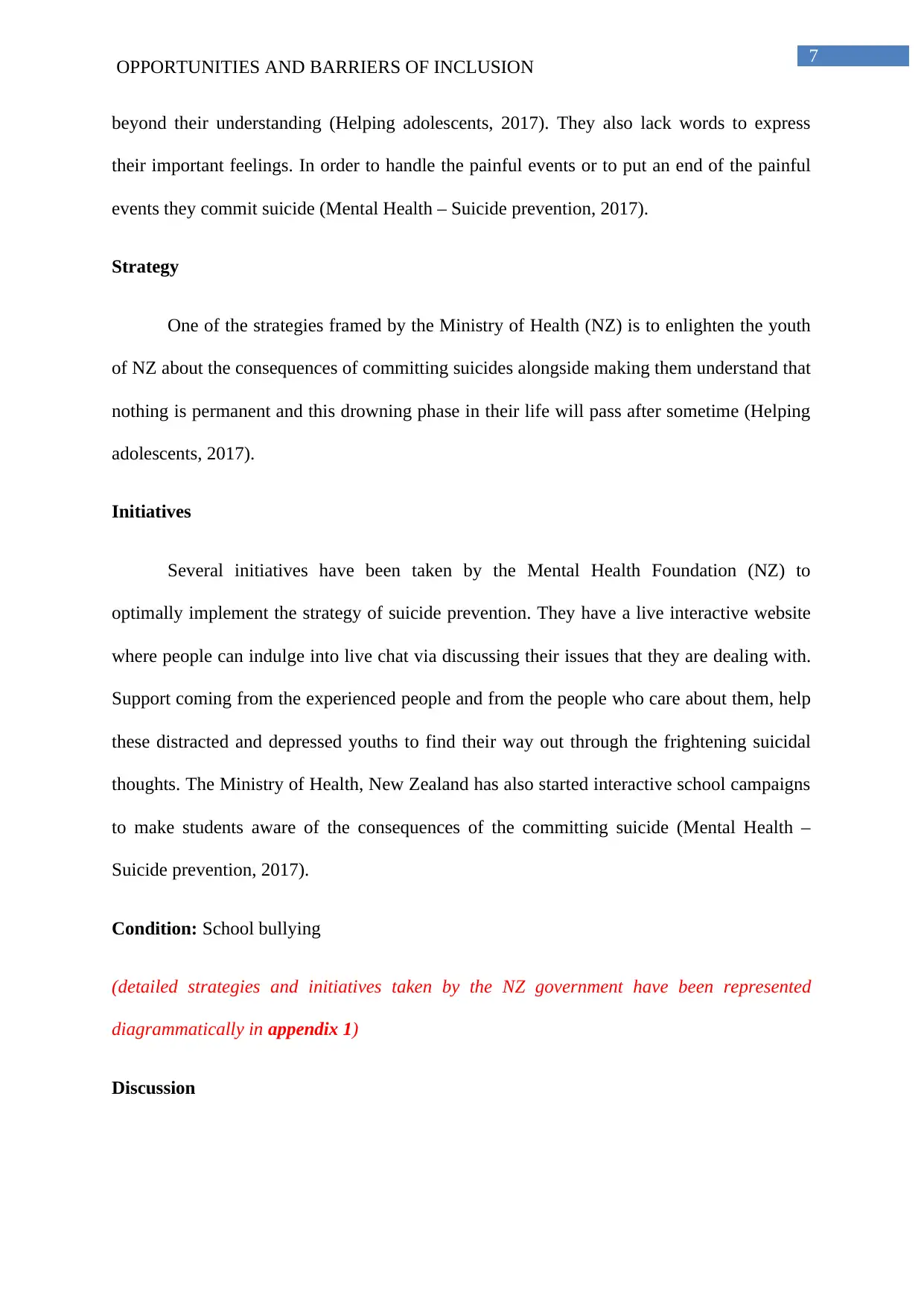
7
OPPORTUNITIES AND BARRIERS OF INCLUSION
beyond their understanding (Helping adolescents, 2017). They also lack words to express
their important feelings. In order to handle the painful events or to put an end of the painful
events they commit suicide (Mental Health – Suicide prevention, 2017).
Strategy
One of the strategies framed by the Ministry of Health (NZ) is to enlighten the youth
of NZ about the consequences of committing suicides alongside making them understand that
nothing is permanent and this drowning phase in their life will pass after sometime (Helping
adolescents, 2017).
Initiatives
Several initiatives have been taken by the Mental Health Foundation (NZ) to
optimally implement the strategy of suicide prevention. They have a live interactive website
where people can indulge into live chat via discussing their issues that they are dealing with.
Support coming from the experienced people and from the people who care about them, help
these distracted and depressed youths to find their way out through the frightening suicidal
thoughts. The Ministry of Health, New Zealand has also started interactive school campaigns
to make students aware of the consequences of the committing suicide (Mental Health –
Suicide prevention, 2017).
Condition: School bullying
(detailed strategies and initiatives taken by the NZ government have been represented
diagrammatically in appendix 1)
Discussion
OPPORTUNITIES AND BARRIERS OF INCLUSION
beyond their understanding (Helping adolescents, 2017). They also lack words to express
their important feelings. In order to handle the painful events or to put an end of the painful
events they commit suicide (Mental Health – Suicide prevention, 2017).
Strategy
One of the strategies framed by the Ministry of Health (NZ) is to enlighten the youth
of NZ about the consequences of committing suicides alongside making them understand that
nothing is permanent and this drowning phase in their life will pass after sometime (Helping
adolescents, 2017).
Initiatives
Several initiatives have been taken by the Mental Health Foundation (NZ) to
optimally implement the strategy of suicide prevention. They have a live interactive website
where people can indulge into live chat via discussing their issues that they are dealing with.
Support coming from the experienced people and from the people who care about them, help
these distracted and depressed youths to find their way out through the frightening suicidal
thoughts. The Ministry of Health, New Zealand has also started interactive school campaigns
to make students aware of the consequences of the committing suicide (Mental Health –
Suicide prevention, 2017).
Condition: School bullying
(detailed strategies and initiatives taken by the NZ government have been represented
diagrammatically in appendix 1)
Discussion
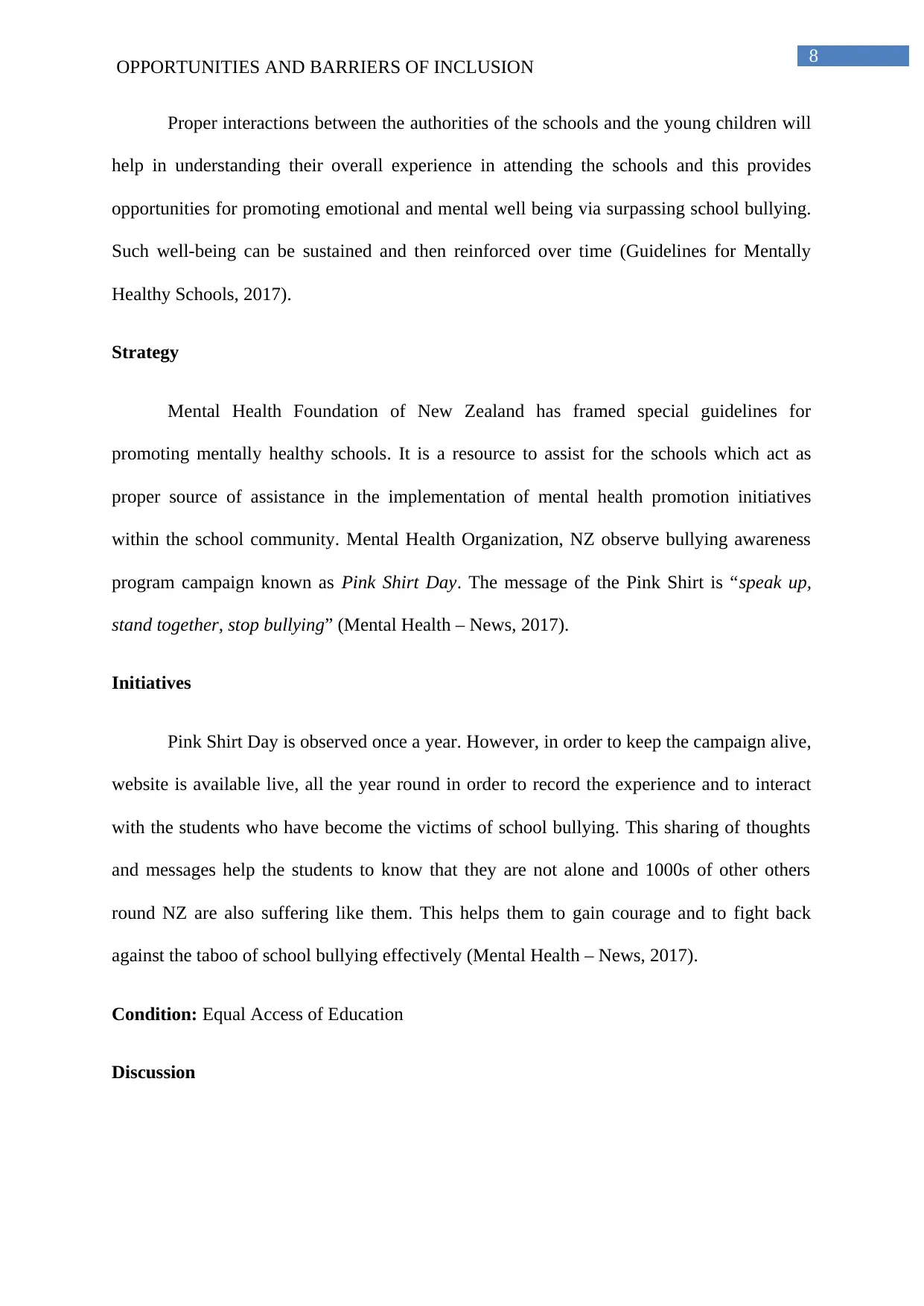
8
OPPORTUNITIES AND BARRIERS OF INCLUSION
Proper interactions between the authorities of the schools and the young children will
help in understanding their overall experience in attending the schools and this provides
opportunities for promoting emotional and mental well being via surpassing school bullying.
Such well-being can be sustained and then reinforced over time (Guidelines for Mentally
Healthy Schools, 2017).
Strategy
Mental Health Foundation of New Zealand has framed special guidelines for
promoting mentally healthy schools. It is a resource to assist for the schools which act as
proper source of assistance in the implementation of mental health promotion initiatives
within the school community. Mental Health Organization, NZ observe bullying awareness
program campaign known as Pink Shirt Day. The message of the Pink Shirt is “speak up,
stand together, stop bullying” (Mental Health – News, 2017).
Initiatives
Pink Shirt Day is observed once a year. However, in order to keep the campaign alive,
website is available live, all the year round in order to record the experience and to interact
with the students who have become the victims of school bullying. This sharing of thoughts
and messages help the students to know that they are not alone and 1000s of other others
round NZ are also suffering like them. This helps them to gain courage and to fight back
against the taboo of school bullying effectively (Mental Health – News, 2017).
Condition: Equal Access of Education
Discussion
OPPORTUNITIES AND BARRIERS OF INCLUSION
Proper interactions between the authorities of the schools and the young children will
help in understanding their overall experience in attending the schools and this provides
opportunities for promoting emotional and mental well being via surpassing school bullying.
Such well-being can be sustained and then reinforced over time (Guidelines for Mentally
Healthy Schools, 2017).
Strategy
Mental Health Foundation of New Zealand has framed special guidelines for
promoting mentally healthy schools. It is a resource to assist for the schools which act as
proper source of assistance in the implementation of mental health promotion initiatives
within the school community. Mental Health Organization, NZ observe bullying awareness
program campaign known as Pink Shirt Day. The message of the Pink Shirt is “speak up,
stand together, stop bullying” (Mental Health – News, 2017).
Initiatives
Pink Shirt Day is observed once a year. However, in order to keep the campaign alive,
website is available live, all the year round in order to record the experience and to interact
with the students who have become the victims of school bullying. This sharing of thoughts
and messages help the students to know that they are not alone and 1000s of other others
round NZ are also suffering like them. This helps them to gain courage and to fight back
against the taboo of school bullying effectively (Mental Health – News, 2017).
Condition: Equal Access of Education
Discussion
⊘ This is a preview!⊘
Do you want full access?
Subscribe today to unlock all pages.

Trusted by 1+ million students worldwide
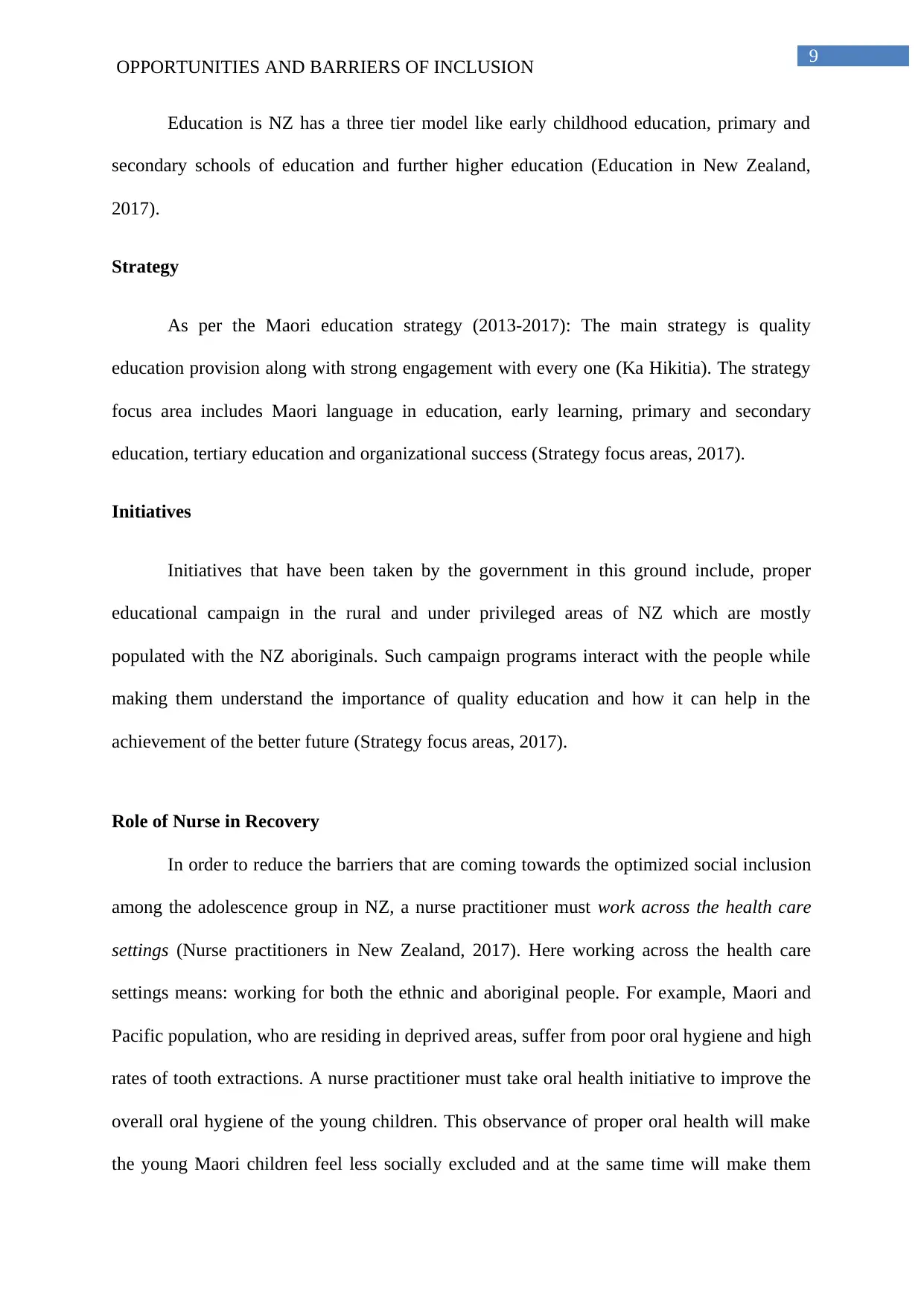
9
OPPORTUNITIES AND BARRIERS OF INCLUSION
Education is NZ has a three tier model like early childhood education, primary and
secondary schools of education and further higher education (Education in New Zealand,
2017).
Strategy
As per the Maori education strategy (2013-2017): The main strategy is quality
education provision along with strong engagement with every one (Ka Hikitia). The strategy
focus area includes Maori language in education, early learning, primary and secondary
education, tertiary education and organizational success (Strategy focus areas, 2017).
Initiatives
Initiatives that have been taken by the government in this ground include, proper
educational campaign in the rural and under privileged areas of NZ which are mostly
populated with the NZ aboriginals. Such campaign programs interact with the people while
making them understand the importance of quality education and how it can help in the
achievement of the better future (Strategy focus areas, 2017).
Role of Nurse in Recovery
In order to reduce the barriers that are coming towards the optimized social inclusion
among the adolescence group in NZ, a nurse practitioner must work across the health care
settings (Nurse practitioners in New Zealand, 2017). Here working across the health care
settings means: working for both the ethnic and aboriginal people. For example, Maori and
Pacific population, who are residing in deprived areas, suffer from poor oral hygiene and high
rates of tooth extractions. A nurse practitioner must take oral health initiative to improve the
overall oral hygiene of the young children. This observance of proper oral health will make
the young Maori children feel less socially excluded and at the same time will make them
OPPORTUNITIES AND BARRIERS OF INCLUSION
Education is NZ has a three tier model like early childhood education, primary and
secondary schools of education and further higher education (Education in New Zealand,
2017).
Strategy
As per the Maori education strategy (2013-2017): The main strategy is quality
education provision along with strong engagement with every one (Ka Hikitia). The strategy
focus area includes Maori language in education, early learning, primary and secondary
education, tertiary education and organizational success (Strategy focus areas, 2017).
Initiatives
Initiatives that have been taken by the government in this ground include, proper
educational campaign in the rural and under privileged areas of NZ which are mostly
populated with the NZ aboriginals. Such campaign programs interact with the people while
making them understand the importance of quality education and how it can help in the
achievement of the better future (Strategy focus areas, 2017).
Role of Nurse in Recovery
In order to reduce the barriers that are coming towards the optimized social inclusion
among the adolescence group in NZ, a nurse practitioner must work across the health care
settings (Nurse practitioners in New Zealand, 2017). Here working across the health care
settings means: working for both the ethnic and aboriginal people. For example, Maori and
Pacific population, who are residing in deprived areas, suffer from poor oral hygiene and high
rates of tooth extractions. A nurse practitioner must take oral health initiative to improve the
overall oral hygiene of the young children. This observance of proper oral health will make
the young Maori children feel less socially excluded and at the same time will make them
Paraphrase This Document
Need a fresh take? Get an instant paraphrase of this document with our AI Paraphraser
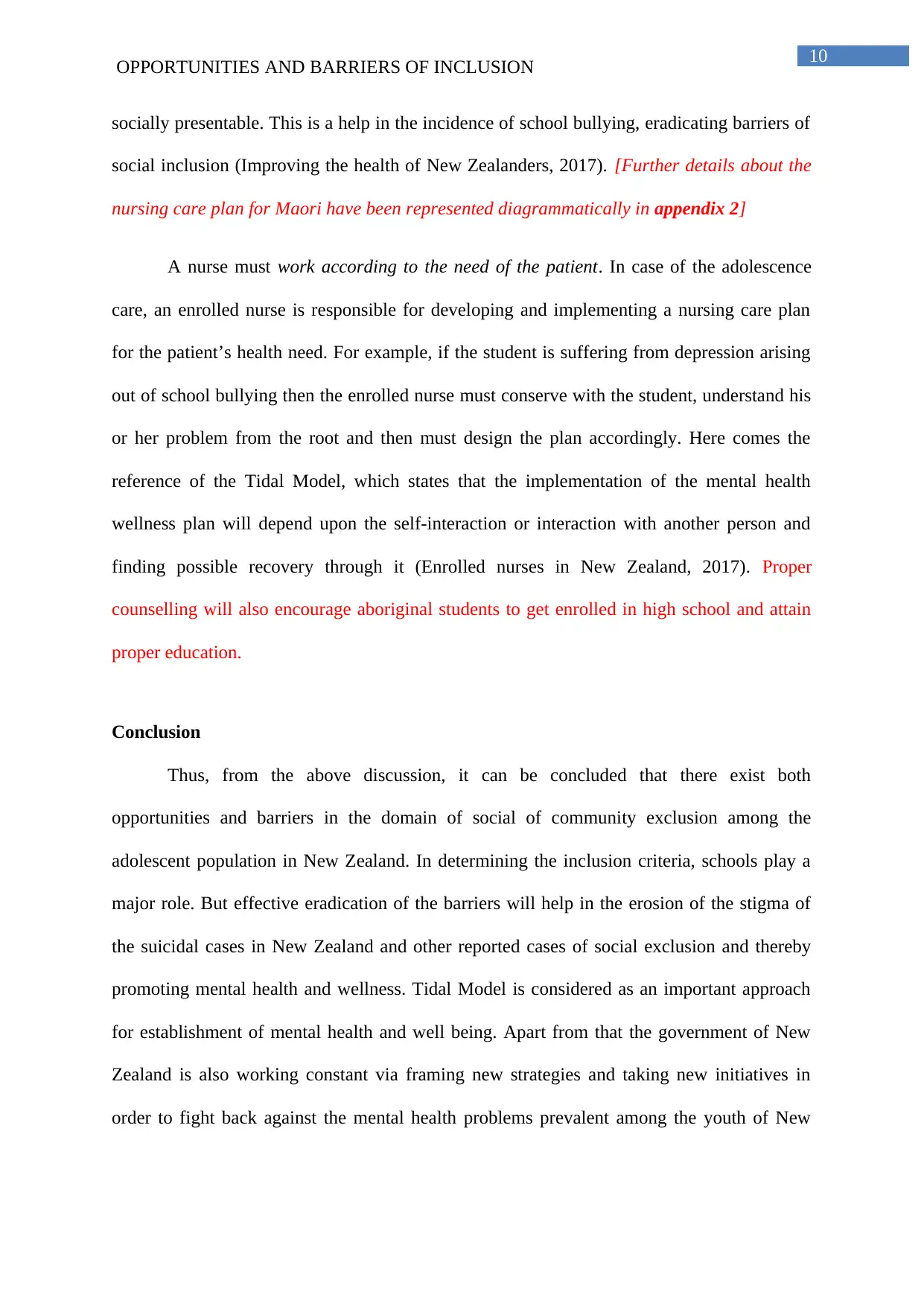
10
OPPORTUNITIES AND BARRIERS OF INCLUSION
socially presentable. This is a help in the incidence of school bullying, eradicating barriers of
social inclusion (Improving the health of New Zealanders, 2017). [Further details about the
nursing care plan for Maori have been represented diagrammatically in appendix 2]
A nurse must work according to the need of the patient. In case of the adolescence
care, an enrolled nurse is responsible for developing and implementing a nursing care plan
for the patient’s health need. For example, if the student is suffering from depression arising
out of school bullying then the enrolled nurse must conserve with the student, understand his
or her problem from the root and then must design the plan accordingly. Here comes the
reference of the Tidal Model, which states that the implementation of the mental health
wellness plan will depend upon the self-interaction or interaction with another person and
finding possible recovery through it (Enrolled nurses in New Zealand, 2017). Proper
counselling will also encourage aboriginal students to get enrolled in high school and attain
proper education.
Conclusion
Thus, from the above discussion, it can be concluded that there exist both
opportunities and barriers in the domain of social of community exclusion among the
adolescent population in New Zealand. In determining the inclusion criteria, schools play a
major role. But effective eradication of the barriers will help in the erosion of the stigma of
the suicidal cases in New Zealand and other reported cases of social exclusion and thereby
promoting mental health and wellness. Tidal Model is considered as an important approach
for establishment of mental health and well being. Apart from that the government of New
Zealand is also working constant via framing new strategies and taking new initiatives in
order to fight back against the mental health problems prevalent among the youth of New
OPPORTUNITIES AND BARRIERS OF INCLUSION
socially presentable. This is a help in the incidence of school bullying, eradicating barriers of
social inclusion (Improving the health of New Zealanders, 2017). [Further details about the
nursing care plan for Maori have been represented diagrammatically in appendix 2]
A nurse must work according to the need of the patient. In case of the adolescence
care, an enrolled nurse is responsible for developing and implementing a nursing care plan
for the patient’s health need. For example, if the student is suffering from depression arising
out of school bullying then the enrolled nurse must conserve with the student, understand his
or her problem from the root and then must design the plan accordingly. Here comes the
reference of the Tidal Model, which states that the implementation of the mental health
wellness plan will depend upon the self-interaction or interaction with another person and
finding possible recovery through it (Enrolled nurses in New Zealand, 2017). Proper
counselling will also encourage aboriginal students to get enrolled in high school and attain
proper education.
Conclusion
Thus, from the above discussion, it can be concluded that there exist both
opportunities and barriers in the domain of social of community exclusion among the
adolescent population in New Zealand. In determining the inclusion criteria, schools play a
major role. But effective eradication of the barriers will help in the erosion of the stigma of
the suicidal cases in New Zealand and other reported cases of social exclusion and thereby
promoting mental health and wellness. Tidal Model is considered as an important approach
for establishment of mental health and well being. Apart from that the government of New
Zealand is also working constant via framing new strategies and taking new initiatives in
order to fight back against the mental health problems prevalent among the youth of New
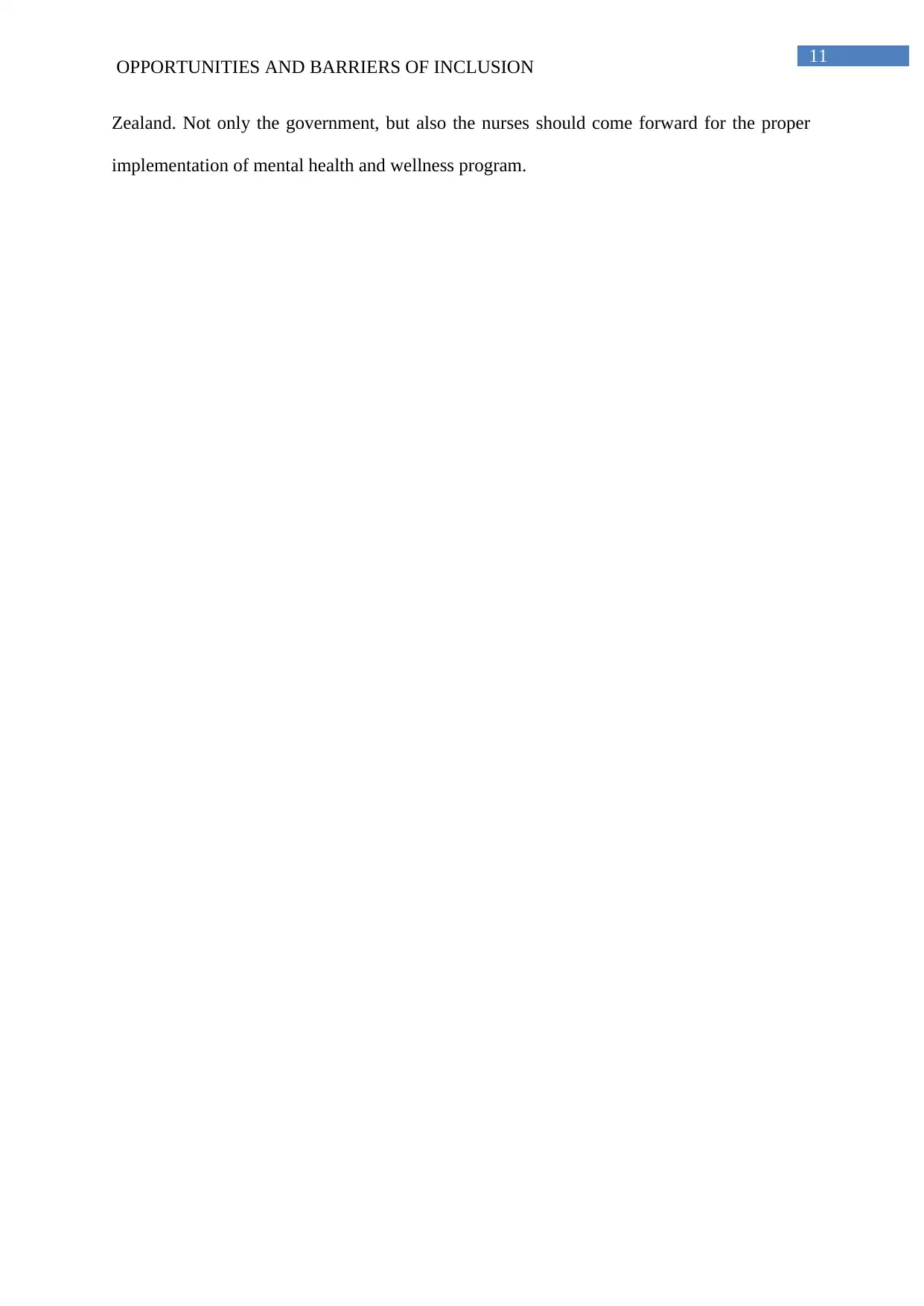
11
OPPORTUNITIES AND BARRIERS OF INCLUSION
Zealand. Not only the government, but also the nurses should come forward for the proper
implementation of mental health and wellness program.
OPPORTUNITIES AND BARRIERS OF INCLUSION
Zealand. Not only the government, but also the nurses should come forward for the proper
implementation of mental health and wellness program.
⊘ This is a preview!⊘
Do you want full access?
Subscribe today to unlock all pages.

Trusted by 1+ million students worldwide
1 out of 18
Related Documents
Your All-in-One AI-Powered Toolkit for Academic Success.
+13062052269
info@desklib.com
Available 24*7 on WhatsApp / Email
![[object Object]](/_next/static/media/star-bottom.7253800d.svg)
Unlock your academic potential
Copyright © 2020–2025 A2Z Services. All Rights Reserved. Developed and managed by ZUCOL.





